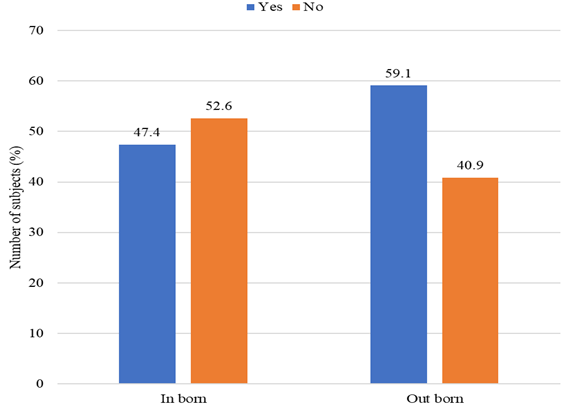Etiology and Clinical feature of neonatal pneumothorax in inborn and outborn NICU settings in rural tertiary care hospital.
Abstract
Background: Neonatal pneumothorax (NP) is a critical condition characterized by air accumulation in the pleural space, leading to lung collapse and respiratory distress. Its incidence varies, with risk factors including prematurity, mechanical ventilation, meconium aspiration syndrome (MAS), congenital pneumonia, and birth asphyxia. Objective: This study aimed to analyze the etiology and clinical presentation of neonatal pneumothorax in inborn and outborn neonates admitted to NICUs of a rural tertiary care hospital. Methods: A descriptive, longitudinal observational study was conducted over two years (December 2020–December 2022) at Dr. Balasaheb Vikhe Patil Rural Medical College, Loni. A total of 60 neonates diagnosed with pneumothorax were included. Clinical history, diagnostic methods (transillumination and chest X-ray), and management strategies were documented. Statistical analysis was performed to assess associations between etiology and outcomes. Results: Out of 60 neonates, 63.3% were inborn, and 36.7% were outborn. The most common etiologies included congenital pneumonia (51.7%), MAS (38.3%), birth asphyxia (25%), and post-surfactant administration in RDS cases (58.3%). Right-sided pneumothorax was more frequent (48.3%), followed by left-sided (28.3%) and bilateral (23.3%). Spontaneous pneumothorax occurred in 26.7% of cases. Mortality was 56.6%, with higher rates among inborn cases (60.5%) than outborn (50%). Conclusion: Neonatal pneumothorax remains a significant challenge in NICU settings, with congenital pneumonia and MAS being the primary causes. Early recognition, prompt intervention, and improved resuscitation techniques, particularly in outborn cases, may reduce mortality. Further research incorporating advanced ventilation strategies like high-frequency oscillatory ventilation (HFOV) is recommended.
Downloads
References
Noppen M, De Keukeleire T. Pneumothorax. Respiration 2008;76:121-127
Smith J, Schumacher RE, Donn SM, Sarkar S. Clinical course of symptomatic spontaneous pneumothorax in term and late preterm newborns: report from a large cohort. Am J Perinatol. 2011;28:163–168
Aly H, Massaro A, Acun C, Ozen M. Pneumothorax in the newborn: clinical presentation, risk factors and outcomes. J Matern Fetal Neonatal Med. 2014 ;27:402-406.
Arshad H, Young M, Adurty R, Singh AC. Acute pneumothorax. Crit Care Nurs Q. 2016;39:176–189.
Park SW, Yun BH, Kim KA, SyKo, Lee YK, Shin SM. A Clinical Study abaut Symptomatic Spontaneous pneumothorax. Korean J Perinatol. 2006;17:304–309.
Vibede L, Vibede E, Bendtsen M.· Pedersen L. Ebbesen F. Neonatal Pneumothorax: A Descriptive Regional Danish Study. Neonatology 2017;111:303-308
Ogata ES, Gregory GA, Kitterman JA, et al. Pneumothorax in the respiratory distress syndrome: incidence and effect on vital signs, blood gases, and pH. Pediatrics 1976;58:177–83. 3.
Goldberg RN, Abdenour GE. Air leak syndrome. In: Spitzer AR, ed. Intensive care of the fetus and neonate. St. Louis, MO: Mosby- Yearbook; 1996:629–40.
Horbar JD, Badger GJ, Carpenter JH, et al. Trends in mortality and morbidity for very low birth weight infants, 1991–1999. Pediatrics 2002;110:143–51.
Yu VYH, Liew SW, Roberton NRC. Pneumothorax in the newborn. Arch Dis Child 1975;50:449–53.
Watkinson M, Tiron I. Events before the diagnosis of a pneumothorax in ventilated neonates. Arch Dis Fetal Neonatal Ed 2001;85: F201–3.
Geary C, Caskey M, Fonseca R, Malloy M. Decreased incidence of bronchopulmonary dysplasia after early management changes, including surfactant and nasal continuous positive airway pressure treatment at delivery, lowered oxygen saturation goals, and early amino acid administration: a historical cohort study. Pediatrics 2008;121:89–96.
Jacobsen T, Gronvall J, Petersen S, Andersen GE. ‘‘Minitouch’’ treatment of very low-birth-weight infants. Acta Paediatr 1993;82: 934–8.
Morley CJ, Davis PG, Doyle LW, et al. COIN trial investigators. N Engl J Med 2008;358:700–8.
Stevens TP, Harrington EW, Blennow M, Soll RF. Early surfactant administration with brief ventilation vs. selective surfactant and continued mechanical ventilation for preterm infants or at risk for respiratory distress syndrome. Cochrane Database Syst Rev 2007; 17:CD003063.
Meberg A, Greve-Isdahl M, Heier CA. Pulmonary air-leakage in newborn infants. Tidsskr Nor Laegeforen 2007;20:2371–3.
Wiswell TE, Tuggle JM, Turner BS. Meconium aspiration syndrome: have we made a difference? Pediatrics 1990;85:715–21.
Ringer SA. Part 3: pneumothorax and air leak. In: Hansen AR, Puder M, editors. 2002 Manual of neonatal surgical intensive care. 2nd ed. Shelton: People’s Medical Publishing House; 2009. p. 188–190.
Ali R, Ahmed S, Qadir M, et al. Pneumothoraces in a neonatal tertiary care unit: case series. Oman Med J. 2013;28(1):67–69.
B APILIOGULLARI, GS SUNAM, S CERAN1 AND H KOC. Evaluation of Neonatal Pneumothorax. The Journal of International Medical Research 2011; 39: 2436 – 2440
Lim HS, Kim H, Jin JY, Shin YL, Park JO, Kim CH, Kim SS. Characteristics of pneumothorax in a neonatal intensive care unit. J Korean Soc Neonatol. 2011 Nov 25;18(2):257-64.
Hany Aly, An Massaro, Ceyda Acun & Maide Ozen (2014) Pneumothorax in the newborn: clinical presentation, risk factors and outcomes, The Journal of Maternal-Fetal & Neonatal Medicine, 27:4, 402-406
Silva IS, Flôr-de-Lima F, Rocha G, Alves I, Guimarães H. Pneumothorax in neonates: a level III Neonatal Intensive Care Unit experience. Journal of Pediatric and Neonatal Individualized Medicine (JPNIM). 2016 Sep 14;5(2):e050220-.
Mannan MA, Dey SK, Jahan N, Iqbal S, Karim SR, Ferdous N. Spectrum of Neonatal Pneumothorax at a Tertiary Care Hospital of Bangladesh: A Retrospective Observational Study. Bangladesh Critical Care Journal. 2019 Mar 27;7(1):12-9.
Avadhesh Joshi, Manish Kumar, Grace Rebekah & Sridhar Santhanam (2022) Etiology, clinical profile and outcome of neonatal pneumothorax in tertiary care center in South India: 13 years’ experience, The Journal of Maternal-Fetal & Neonatal Medicine, 35:3, 520-524
Al-Anbari AJ, Abid JK. Evaluation of Pneumothorax in Neonates in Al Immamian Alkadhomain Medical City. European Journal of Molecular & Clinical Medicine. 2020;7(2):214-9.
Jovandaric, M.Z.; Milenkovic, S.J.; Dotlic, J.; Babovic, I.R.; Jestrovic, Z.; Milosevic, B.; Culjic, M.; Babic, S. Neonatal Pneumothorax Outcome in Preterm and Term Newborns. Medicina 2022, 58, 965.
J. Andersson, A. Magnuson & A. Ohlin (2021): Neonatal pneumothorax: symptoms, signs and timing of onset in the post-surfactant era, The Journal of Maternal-Fetal & Neonatal Medicine, DOI: 10.1080/14767058.2021.1882981
Eun-Ah Kim, MD1,2, Jae-Hun Jung, MD1,2, Sang-Yoon Lee, MD1,2, Sook-Hyun Park, MD, PhD1,2, and Ji Sook Kim, MD, PhD1,2 Neonatal Pneumothorax in Late Preterm and Full-Term Newborns with respiratory Distress: A Single-Center Experience.



























